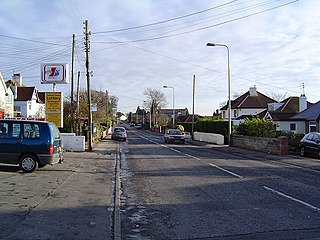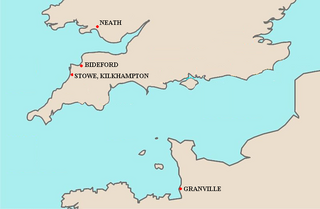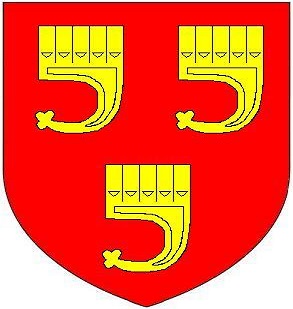
Robert Fitzhamon, or Robert FitzHamon, Seigneur de Creully in the Calvados region and Torigny in the Manche region of Normandy, was the first Norman feudal baron of Gloucester and the Norman conqueror of Glamorgan, southern Wales. He became Lord of Glamorgan in 1075.

Sully is a village in the community of Sully and Lavernock, in the Vale of Glamorgan, Wales, lying on the northern coast of the Bristol Channel, midway between the towns of Penarth and Barry and 7 miles southwest of the Welsh capital city of Cardiff.

St Donat's Castle, St Donats, Wales, is a medieval castle in the Vale of Glamorgan, about 16 miles (26 km) to the west of Cardiff, and about 1+1⁄2 miles (2.4 km) to the west of Llantwit Major. Positioned on cliffs overlooking the Bristol Channel, the site has been occupied since the Iron Age, and was by tradition the home of the Celtic chieftain Caradog. The present castle's origins date from the 12th century when the de Haweys and later Peter de Stradling began its development. The Stradlings held the castle for four hundred years, until the death of Sir Thomas Stradling in a duel in 1738.

Barbara Sidney, Countess of Leicester was a Welsh heiress, and the first wife of Robert Sidney, 1st Earl of Leicester. Her family connections tied her to prominent contemporary figures such as Sir Walter Raleigh.

The Lordship of Glamorgan was one of the most powerful and wealthy of the Welsh Marcher Lordships. The seat was Cardiff Castle. It was established by the conquest of Glamorgan from its native Welsh ruler, by the Anglo-Norman nobleman Robert FitzHamon, feudal baron of Gloucester, and his legendary followers the Twelve Knights of Glamorgan. The Anglo-Norman Lord of Glamorgan, like all Marcher lords, ruled his lands directly by his own law: thus he could, amongst other things, declare war, raise taxes, establish courts and markets and build castles as he wished, without reference to the Crown. These privileges were only lost under the Laws in Wales Acts 1535–1542. Though possessing many castles, the main seat of the Lordship was Cardiff Castle.
This page is a list of High Sheriffs of Glamorgan. Sheriffs of Glamorgan served under and were answerable to the independent Lords of Glamorgan until that lordship was merged into the crown. This is in contrast to sheriffs of the English shires who were from the earliest times officers of the crown. Sheriffs in the modern sense, appointed and answerable to the crown, were instituted in the county of Glamorgan in 1541.

The Stradling Baronetcy, of St Donat's in the County of Glamorgan, was a title in the Baronetage of England. It was created on 22 May 1611 for John Stradling, later Member of Parliament for St Germans and Old Sarum and Glamorgan. The second Baronet also represented Glamorgan in Parliament. The fifth Baronet was member of Parliament for Cardiff. The title became extinct on the death of the sixth Baronet in 1738.

Sir John Stradling, 1st Baronet, was an English poet, scholar and politician.
Mabel FitzRobert, Countess of Gloucester was an Anglo-Norman noblewoman, and a wealthy heiress who brought the lordship of Gloucester, among other prestigious honours to her husband, Robert, 1st Earl of Gloucester upon their marriage. He was the illegitimate son of King Henry I of England.

Newcastle Castle is a medieval castle located on Newcastle Hill, Newcastle, overlooking the town centre of Bridgend in Glamorgan, South Wales. It was originally believed to date from 1106 when a ringwork was created at the site by the Norman baron Robert Fitzhamon. Some of the fine stonework survives, but today the castle is ruinous.
Sir Gilbert Denys of Siston, Gloucestershire, was a soldier, and later an administrator. He was knighted by January 1385, and was twice knight of the shire for Gloucestershire constituency, in 1390 and 1395 and served as Sheriff of Gloucestershire 1393-4. He founded the family which provided more Sheriffs of Gloucestershire than any other.
Einion ap Collwyn, was a Welsh prince and warrior supposed to have existed in the eleventh century. Not mentioned in medieval chronicles, he is the subject of possibly legendary or fictional writings from the sixteenth century onwards, the oldest surviving report being that of the Tudor antiquary John Leland. Some Welsh family genealogies claimed descent from Einion.
Manor of Siston is the ancient manor in Siston in South Gloucestershire, England.

Hamon Dentatus was a Norman baron who was killed while rebelling with other Norman barons against William II, Duke of Normandy at the Battle of Val-ès-Dunes. The epithet "Dentatus" or "Dens" was probably given to Hamon because he was born with teeth. Little is known about Hamon's life.
The feudal barony of Gloucester or Honour of Gloucester was one of the largest of the mediaeval English feudal baronies in 1166, comprising 279 knight's fees, or manors. The constituent landholdings were spread over many counties. The location of the caput at Gloucester is not certain as Gloucester Castle appears to have been a royal castle, but it is known that the baronial court was held at Bristol in Gloucestershire.

Sir Richard de Grenville was one of the Twelve Knights of Glamorgan who served under Robert FitzHamon, in the conquest of Glamorgan in Wales. He obtained from FitzHamon the lordship of Neath in which he built Neath Castle and in 1129 founded Neath Abbey. He is by tradition the founder and ancestor of the prominent Westcountry Grenville family of Stowe in the parish of Kilkhampton in Cornwall and of Bideford in Devon, the later head of which family was John Granville, 1st Earl of Bath (1628–1701). The surname of his supposed descendants the Westcountry Grenville family was spelled by tradition "Grenville" until 1661 when it was altered to "Granville".
Sir Edward Stradling (1529–1609) was a Welsh politician, antiquary and literary patron.

The manor of Bideford in North Devon was held by the Grenville family between the 12th and 18th centuries. The full descent is as follows:

Richard Grenville lord of the manor of Stowe, Kilkhampton in Cornwall and of Bideford in Devon, was an English soldier, politician, and administrator who served as a Member of Parliament for Cornwall in 1529, and served as Sheriff of Cornwall and Sheriff of Devon.

Sir John Sully, KG, of Ruxford and Iddesleigh in Devonshire, was an English knight. He was one of the many deponents who gave evidence in Scrope v Grosvenor, one of the earliest heraldic law cases brought in England, at which time he stated his age as 105. In about 1362, he was appointed by King Edward III as the 39th Knight of the Garter.











